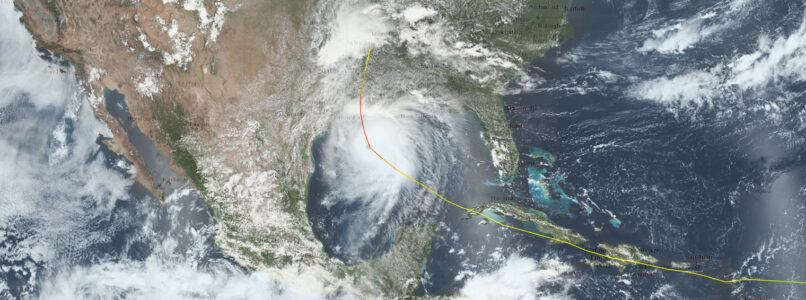HURRICANE LAURA DAMAGE TO WOOD-FRAMED RESIDENCES
By Tim Marshall, P.E., Principal Engineer, Meteorologist
On August 27, 2020, Hurricane Laura struck southwest Louisiana and extreme southeast Texas. Emeritus Engineer and Meteorologist experienced the hurricane firsthand in Lake Charles, LA then spent three days conducting a damage survey. The primary purpose of the damage survey was to evaluate the performance of various structures that experienced strong winds. This blog will focus on wind damage to residences.
Hurricane Laura made landfall at Cameron, LA around 0600 Universal Time Code (UTC) on August 27, 2020. According to the Lake Charles National Weather Service (NWS), Laura was the strongest hurricane to strike southwest Louisiana since records began in 1851. The hurricane moved due north toward Lake Charles at about 4.5 m/s (10 mph) weakening slowly. The NWS in Lake Charles recorded the highest wind gust of 116 kt (133 mph) out of the east at 0732 UTC before the wind equipment failed. However, the Florida Coastal Monitoring Program (FCMP) erected a portable tower at Chennault International Airport on the east side of Lake Charles and had obtained a continuous wind record with peak wind gust of 115 kt (132 mph) out the east at 10 m (33 ft). A second FCMP site in Sulphur, LA recorded a peak wind gust of 96 kt (110 mph) from the east also on a 10 m (33 ft) tower.
There was widespread wind damage to residences in the Lake Charles area particularly to roof coverings. In some cases, homes experienced structural damage when conventional toenailed roof structures failed aided by broken windows or doors on the windward sides of buildings which increased internal wind pressures. In addition, trees fell on many homes causing structural damage. Commonly observed problems were improper attachment of roof coverings especially when asphalt shingles were nailed too high above the sealant strips. Some fasteners were overdriven tearing through the shingles. Shingles typically were fastened with four nails per shingle instead of the required six nails for hurricane prone areas. The combination of high nailing, overdriven fasteners, and fewer fasteners than required resulted in less than half the required number of fasteners in the shingles to resist wind uplift. As a result, there was widespread wind damage to asphalt shingle roofs particularly on windward slopes. Wind damage included combinations of flipped, creased, torn, and removed shingles. Asphalt shingle roofs that were nailed correctly sustained far less wind damage than those roofs that were not installed correctly. Loss of roof coverings and underlayment allowed water ingress which greatly increased the amount of interior damage to residences. Refer to Figure 1.
The vast majority of residences had Degrees of Damage (DoDs) of 4 or less on the Enhanced Fujita or EF-scale with damage limited to roof coverings and cladding items. A small percentage of homes experienced DoD 6 damage where they had windward windows or garage doors fail allowing internal pressures to help lift and remove the roofs. Refer to Figure 2. Expected failure wind speeds for DoD 4 damage is around 43 m/s (97 mph) where expected failure wind speeds for DoD 6 is around 55 m/s (122 mph). Thus, we found the wind speeds listed in the EF-scale agreed well with the DoDs and locally measured wind speeds. See Table 1.
Where roof failures occurred, there was no evidence of metal straps or clips used to attach rafters to wall top plates. Roof failures initiated where rafters were toenailed to wall top plates. Nails were simply pulled out of the wood. No doubt such roof failures would have been prevented had steel straps been installed properly as these connections can exceed 1000 lbs. whereas toenailed connections with 16d nails have an average pull out strength of about 300 lbs. The vast majority of homes that were better built (continuous load paths that were well anchored) were able to survive a major hurricane.
Figure 1. Typical wind damage to asphalt shingle roof coverings on residences. The inset image shows high nailing (yellow circles) with nails missing the top laps in the overlying shingles (red circles).

Figure 2. House in Vivian, LA which lost the entire roof structure. The front side of house faced north and was windward to the strongest winds. Failure of the front doors and windows allowed internal pressure to help lift the roof. Inset image (A) shows upside down roof in the backyard with “birdsmouth” cut outs in rafters (circled) and close-up of broken toenailed connection (B) where two parallel rust stains indicated where nails had been.

Table 1. DoDs for residences from the EF-scale document.

By Tim Marshall, P.E., Meteorologist, Haag Principal Engineer

Tim Marshall is a structural engineer and meteorologist. He has served as a Haag Engineer since 1983, assessing damage to thousands of structures (particularly damage caused by wind and other weather phenomena). He has written numerous articles, presented countless lectures, and appeared on dozens of television programs in order to share his extensive knowledge re: storms and the resultant damage. He is a primary author of many Haag Education materials, including the Haag Certified Inspector-Wind Damage course. He is also a pioneering storm chaser and was editor of Storm Track magazine. See his profile here.
Any opinions expressed herein are those of the author(s) and do not necessarily reflect those of Haag Engineering Co., Haag Construction Consulting, Haag Education, or parent company, Haag Global, Inc.

